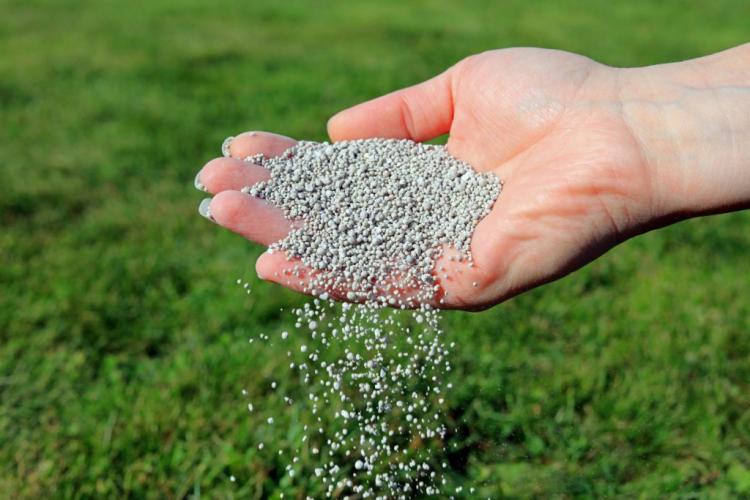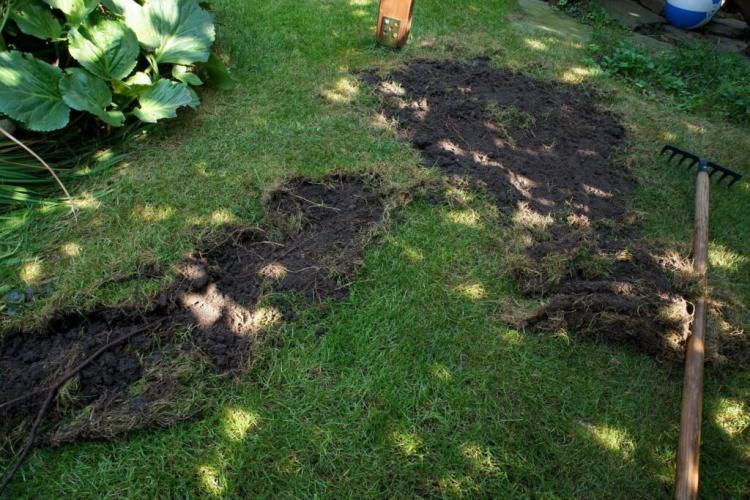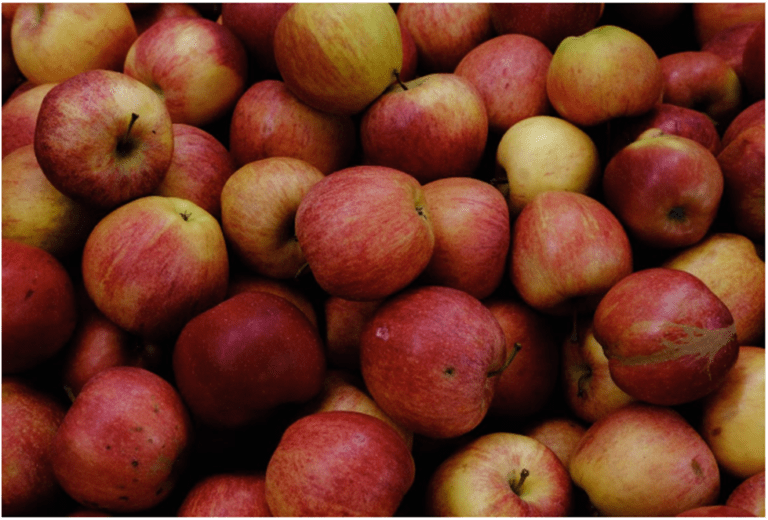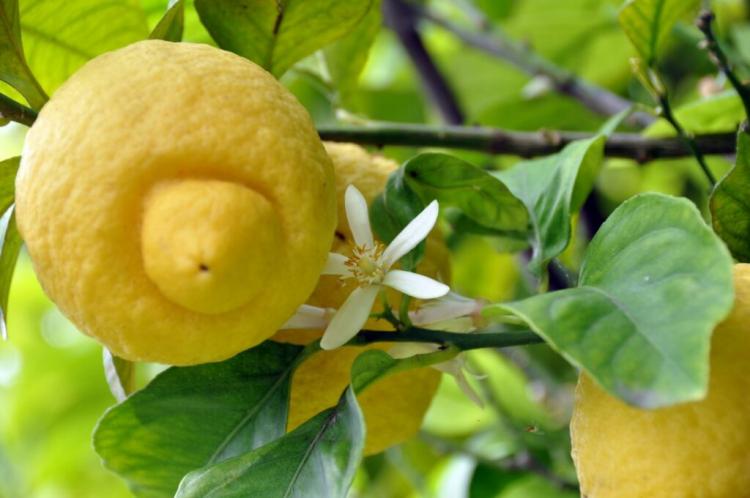Fertilizing lawns: fertilizing tips from lawn experts
Maintaining the lawn is particularly demanding and not easy for many. We explain when, how and with what to properly fertilize your lawn.
The fertilization of the lawn leaves many garden owners desperate and far too rarely does the green carpet get exactly the nutrient supply that makes it green and lush. Knowledge of the right fertilizer, the right frequency and the perfect time are of decisive importance for correct fertilization. We would like to convey this knowledge to you in this overview article. Here you can find out how fertilization is carried out in spring, summer or autumn, how the use of organic and mineral lawn fertilizers differs and how deficiency or excess symptoms can be recognized and treated.
If you are at a loss when faced with a dry, ragged or holey lawn, the problem may be incorrect fertilization. We will help you and answer important questions about fertilizing lawns.
Fertilizing the lawn: the right time
Table of Contents
Well-planned fertilization guarantees that the lawn grasses are always properly cared for. This includes the fact that only small amounts of nutrients are present in phases of low growth. Because when using mineral lawn fertilizers, too much fertilization at the wrong time can have serious consequences: On the one hand, the lawn can be damaged, on the other hand, unused nutrients may be leached into the groundwater or the soil quality suffers.
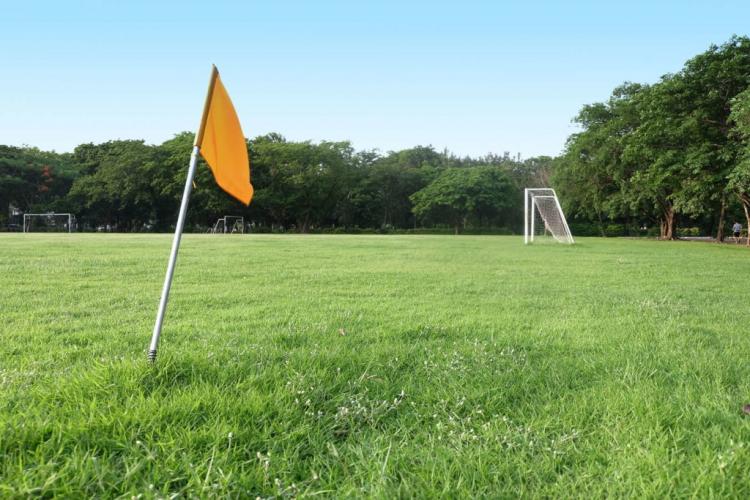
Only lawns that are heavily used have to be fertilized several times a year [Photo: MAEWJPHO / Shutterstock.com]
In the private sector, two to three fertilizations per year are usually completely sufficient. The first fertilization takes place between February and April to stimulate budding and to provide nutrients for the summer. If you have chosen a very early date and have used a fertilizer without long-term effects, further fertilization in early summer may be necessary. From July until October at the latest, you should use a potassium-accentuated autumn lawn fertilizer such as our Plantura organic autumn lawn fertilizer.
Tip: More frequent fertilization is only necessary on heavily used and very frequently mowed lawns. Examples of this are ornamental and sports lawns.
You can find out more about the right time to fertilize your lawn in this article.
Fertilize lawn in spring
When your lawn actually needs fertilization for the first time depends on the quality of the soil below:
- Light, sandy soil does not store enough nutrients for the lawn to sprout quickly and vigorously in spring. In order not to let weeds take precedence, a lawn on such a soil should be supported with early fertilization. Fertilize in February with an organic lawn fertilizer or between March and April with a mineral or organic-mineral lawn fertilizer.
- A clayey, very loamy or humus-rich soil usually has enough nutrient reserves to ensure rapid and vigorous budding in spring. You should only fertilize a lawn on such potent soil when its natural growth subsides. You can recognize this by the fact that you have to mow less often. Fertilize with an organic lawn fertilizer for the first time between April and May, with an organic-mineral or mineral lawn fertilizer between May and June.
- If you are not sure about the condition of your soil, you can also have a soil analysis carried out – this is offered, for example, by the Raiffeisen laboratory service. Or you can observe the growth behavior of your lawn closely and orientate yourself in the coming year on the noted times of expulsion and declining growth.
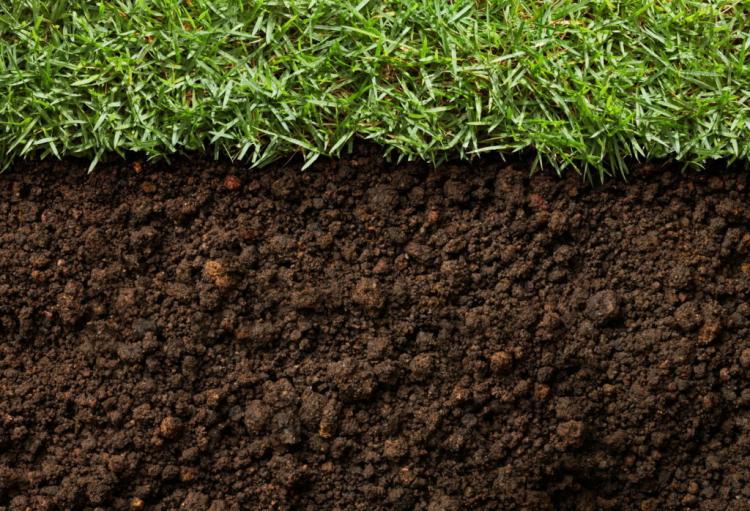
You should only fertilize very humus-rich soils when natural growth subsides [Photo: ifong / Shutterstock.com]
You can read more about the subject of “fertilizing lawns in spring” here in our special article. We have also put together everything else for you to reawaken the lawn after winter.
Fertilize lawns in summer
Fertilizing in early summer may be necessary because there was not enough fertilization in spring – or it is already a preparation for winter, which can already begin in summer. In summer, however, it is important to be aware of the drought: Plants only absorb nutrients from the watery soil solution. So if you fertilize in summer, rain should be the order of the day – or you water after fertilizing. You can find out more about lawn fertilization in summer here.
Fertilize lawn in autumn
Fertilizing in autumn prepares the lawn plants for winter. Special autumn lawn fertilizers provide less nitrogen, but more potassium than normal lawn fertilizers. Potassium is involved in the formation of cell walls and the development of frost tolerance for the winter. It is better not to postpone this important preparation for winter to the last possible date so that the lawn has enough time to use the nutrient. The application of organic autumn lawn fertilizer is possible from June, the fertilization should be done by the end of October at the latest. Autumn lawn fertilizer also contains nitrogen, so that your lawn stays green into winter and, ideally, even throughout winter.
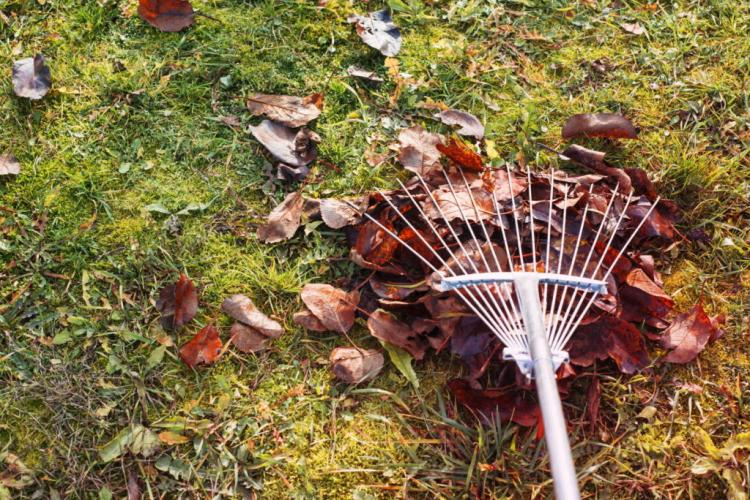
A high-potassium fertilizer should be used in autumn [Photo: Alena TS / Shutterstock.com]
Tip: Under no circumstances should you use a mineral, nitrogen-based lawn fertilizer in autumn. Since nitrogen stimulates growth, another strong shoot would be the result. This fresh shoot is then susceptible to frost and at risk of freezing to death over the winter and hindering the shoot in the coming year.
You can find more detailed information on the subject of “Fertilizing the lawn in autumn” in our special article. You can also read about everything else about preparing the lawn for winter here.
The right weather for lawn fertilization
The right weather for fertilizing the lawn is when it is damp and covered. After fertilization, rain should be announced, otherwise watering is necessary. If the fertilizer is not washed in with water after it has been applied, it works more slowly on the one hand. On the other hand, mineral lawn fertilizers can cause “burns” on dry soil, which are caused by the sudden high salt concentration.
Tip: It is best to mow the lawn freshly before fertilizing the lawn. If the lawn is to be scarified in spring, the first fertilization should only be carried out afterwards.
Fertilize the lawn: how often and how much?
As mentioned at the beginning, two to three fertilizations per year are completely sufficient for the vast majority of private turf areas. The fertilized amounts depend on the selected type of fertilizer: Always pay close attention to the dosage recommendation in order to avoid unnecessary costs and damage to the lawn, soil and the environment. For a utility lawn with low pollution – as most garden owners call it their own – we have created an exemplary annual fertilization plan for you below. Please note that this information is a rough guide value that varies depending on the type of fertilizer and the load: Fertilizers with less nutrients are used in larger quantities and areas that are heavily used require up to twice as many nutrients as less used.
| Lawn type | March | April | May | June | July | August | September to October |
|---|---|---|---|---|---|---|---|
| Utility lawn | 80 g / m2 (*) |
30 g / m2 (*) |
50 – 80 g / m2 (**) |
||||
| Heavy-duty lawn with medium loads | 80 g / m2 (*) |
50 g / m2 (*) |
30 g / m2 (*) |
50 – 80 g / m2 (**) |
(*) = Suitable for our Plantura organic lawn fertilizer
(**) = Suitable for our Plantura organic autumn lawn fertilizer
Tip: Mowing and removing the clippings removes many nutrients from the lawn, which you then have to replenish through fertilization. For this reason, mowing with mulching mowers means that you do not need to fertilize as much.
Fertilize turf
Rolled lawns also need fertilization. Basically, exactly the same applies to it as to a sown lawn. There is only one little thing to consider immediately after laying: the floor under the turf should have been fertilized with a full mineral fertilizer before laying. This fertilization “from below” ensures that the lawn mats root down into the existing soil as quickly as possible, so that the lawn becomes stable and can absorb water.
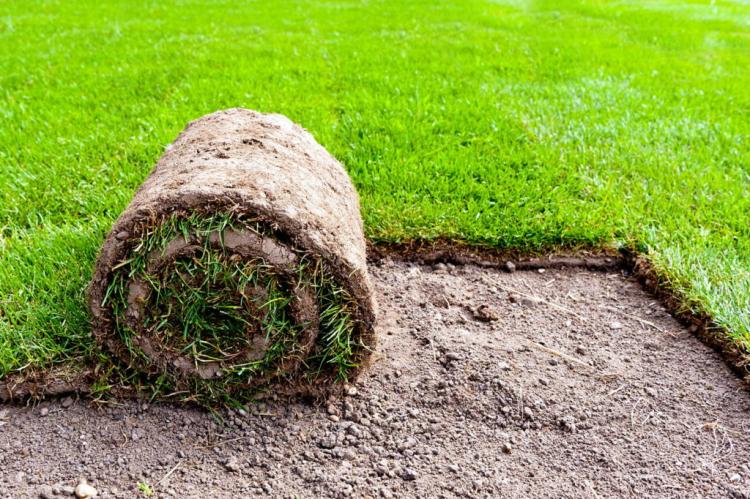
The same principles apply to the fertilization of rolled turf as to normal lawn [Photo: borzywoj / Shutterstock.com]
The rooting takes – depending on the weather – about three to five weeks. During this time you should not fertilize a turf so as not to disturb the roots. The first fertilization after laying depends on the season in which the lawn was laid. For better orientation, we have summarized this dependency in a table below.
| Turf was laid in … | First fertilization takes place in … |
|---|---|
| spring | Early summer |
| Early summer | Early fall |
| Early fall | Autumn, with organic autumn lawn fertilizer |
| Late autumn or winter | Spring, with organic fertilizer |
You can find more detailed information on fertilizing turf here.
Recognize nutrient deficiencies in the lawn
A lack of nutrients can occur very quickly in demanding plants such as lawn grasses. If you find out that a certain nutrient is deficient, it can be fertilized individually or with a suitably composed compound fertilizer.
A yellowish color of the stalks is typical of a nitrogen deficiency. However, you can remedy this with a fast-acting nitrogen fertilizer. Of course, it is better to have an optimal supply of organic fertilizers or long-term fertilizers that prevent such a deficiency from occurring in the first place.
A yellowing and drying out in hot summer can unfortunately also mean that the lawn is insufficiently supplied with potassium, which increases the tolerance to heat stress and lack of water. In autumn and winter, a potassium deficiency leads to frost damage and thus to yellow, muddy and dead grasses.
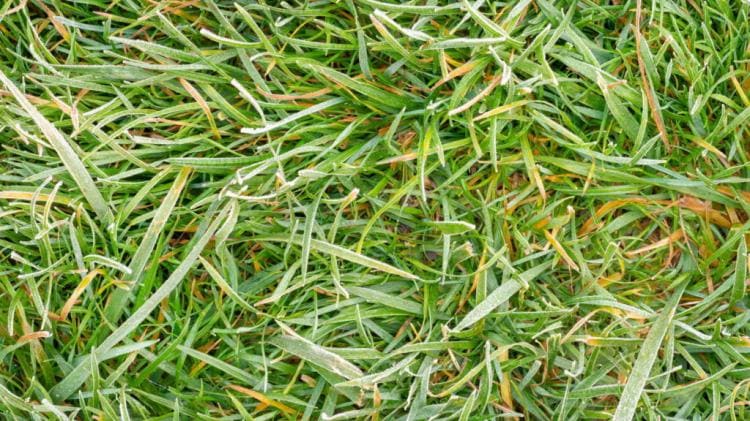
Frost damage suggests too much nitrogen or too little potassium [Photo: Sergii Kuchugurnyi / Shutterstock.com]
A lack of phosphate can be observed extremely rarely: the lawn turns dark green to green-purple. In this case, however, refrain from increasing the phosphate fertilization immediately: it might not have any effect at all. Because often enough phosphate is present in the soil, but because the pH value is too high or too low, insoluble compounds with calcium, iron or aluminum ions form. To ensure that the phosphate is dissolved and available to the plants, a pH value of 6.0 to 6.5 is optimal. In the event of a phosphate deficiency, we therefore recommend that you first test the pH value of your soil before even more phosphate fertilizer is simply left to “fix” in the soil.
The nutrient element magnesium is also very important for a healthy lawn. A magnesium deficiency manifests itself in a similar way to a nitrogen deficiency, but the leaf veins of the stalks remain green longer. So checking this may require you to take a really close look at your lawn. Most lawn fertilizers contain sufficient amounts of magnesium.
Recognize overfertilization of the lawn
Like all plants, lawns suffer not only from a deficiency, but also from an excess of nutrients. A small excess leads to typical nutrient damage, which is summarized in the table below.
| Nutritional element | Excess symptom |
|---|---|
| Nitrogen (N) | – Excessive growth – Soft straws – susceptibility to frost damage – Dark green color – Causes calcium and magnesium deficiency |
| Phosphate (P) | – No / hardly any symptoms on the plant – “Fixing” in the ground |
| Potassium (K) | – Causes calcium deficiency |
| Magnesium (Mg) | – Causes calcium deficiency |
In the case of very strong over-fertilization, as can only occur with mineral fertilizers, the lawn is “burned”: The high concentration of dissolved salts in the soil leads to a strong loss of fluid in the grass and thus to death. You can find out more about the license plate number and how to avoid over-fertilization of the lawn in this special article.

Excessive use of mineral lawn fertilizers can damage the lawn [Photo: SingjaiStock / Shutterstock.com]
The right lawn fertilizer
The choice of lawn fertilizer determines how often and at what time you can or must fertilize your lawn. The type of nutrient supply also has a huge impact on the health and quality of the soil. This in turn determines to a large extent how evenly your lawn grows, how well it sprouts in spring, how well it is supplied with water and how healthy the roots grow.
Mineral lawn fertilizers
Mineral lawn fertilizers contain nutrients in salt form. After application, these dissolve very easily in the water in the soil. Once they are dissolved, they can be immediately absorbed by the plants. In summary, mineral lawn fertilizers have the following advantages and disadvantages:
Advantages of mineral lawn fertilizers
- Fast action
- Cheap price
Disadvantages of mineral lawn fertilizers
- Mineral fertilizers are degraded with high energy expenditure or from fossil deposits, the production is environmentally harmful
- Mineral fertilizers bypass many chemical and biological processes that lead to the release of nutrients in natural locations. Therefore fertilization errors can easily occur. Possible consequences are: an unfavorable change in the pH value, excess symptoms, loss of nutrients and damage to the environment through leaching, over-fertilization and a reduction in soil quality
Since the use of mineral fertilizers leads to fertilization errors much more quickly, we recommend that you leave the use of mineral fertilizers to trained specialists.

The use of mineral fertilizers can quickly lead to over-fertilization [Photo: Bochkarev Photography / Shutterstock.com]
Tip : A certain exception applies to mineral fertilizers with long-term effects. These make plant damage and leaching less likely through a special coating and a slow release of the nutrients. However, they too will ultimately degrade the quality of the soil if organic material does not occasionally get into the soil. You can read more about mineral fertilizers in general here.
Organic lawn fertilizer
Organic or mainly organic lawn fertilizers such as our Plantura organic lawn fertilizers contain nutrients in organic form. This means that they are packaged in a natural casing. This shell is broken down more or less quickly by soil organisms, which releases the nutrients. Organic lawn fertilizers have the following advantages and disadvantages:
Benefits of organic lawn fertilizers
- Organic fertilizers release nutrients slowly and for a long time, which means that there is never overfertilization and rarely leaching
- Organic fertilizers have a natural long-term effect
- Due to the natural release of nutrients, the soil chemistry remains in balance
- Soil organisms are promoted: Useful insects, bacteria, fungi and worms rummage through the soil and ensure good ventilation and mixing
- Depending on the type of organic fertilizer, more or less humus is formed. You can also read more about humus and its advantages here
- In particular, the demanding maintenance of lawns is made easier, since forgotten or late fertilization appointments are less of a consequence
Disadvantages of organic lawn fertilizers
- The effect of organic fertilizers is always a little delayed, so that it is necessary to fertilize with foresight
The Plantura organic lawn fertilizer developed by us and our organic autumn lawn fertilizer also have all of the advantages mentioned. In addition, both are free from animal components, the raw materials used are obtained in the food industry. This makes our fertilizers even more sustainable than other fertilizers based on slaughterhouse waste.

Our Plantura organic lawn fertilizers have a natural long-term effect and promote soil life
You can find an overview of all mineral and organic lawn fertilizers, their use, advantages and disadvantages in our special article.
Tip: Organic-mineral lawn fertilizers are also suitable for fertilizing lawns. The combination of organic and mineral components enables both a short-term and a long-term effect. You can use these fertilizers to meet acute nutritional needs – without the risk of plant damage, leaching or damage to soil life.
Fertilizing lawns with lime: an important contribution to nutrient supply?
The liming of lawns has a long tradition. Until a few years ago, lawns were preferably supplied with mineral fertilizers. Ammonium was often used as a nitrogen supplier. Since the supply of ammonium leads to a drop in the pH value, this trend had to be counteracted by regular liming.
A lawn on normal garden soil that is fertilized with organic fertilizers does not require regular lime additions. Rather, the inexperienced use of lime can even lead to problems: An excessively high calcium content in the soil leads to the establishment of phosphate and thus possibly to a phosphate deficiency in the lawn. In addition, a pH value that is too high does not offer optimal growth conditions for lawn grasses – rather, lime-tolerant or lime-loving wild herbs are favored. For this reason, the following applies: If you think that liming is necessary, it is better to test the pH of your soil beforehand. You can carry out this pH soil test yourself or take advantage of a soil analysis such as that offered by the Raiffeisen laboratory service.

Creating a beautiful lawn on a wooded property requires regulating the soil pH [Photo: Joseph Thomas Photography / Shutterstock.com]
Of course, exceptions confirm the rule here. Many a plot of land has soils with an extremely low pH value. This applies in particular to forest properties and those that border on former or existing bog areas. Regular liming may actually be necessary to maintain a moderate pH value so that the optimum pH value of 6.5 for the lawn is maintained.
You can also find more detailed information on liming the lawn in this special article.
Tip: If ammonium is fertilized together with nitrate – as calcium ammonium nitrate or ammonium sulphate nitrate – the pH value does not drop. However, the supply of mineral nutrients has other disadvantages, as you learned in the section “Mineral lawn fertilizers” above.


